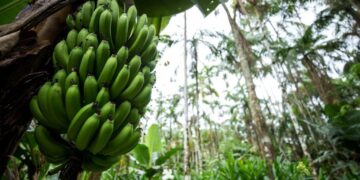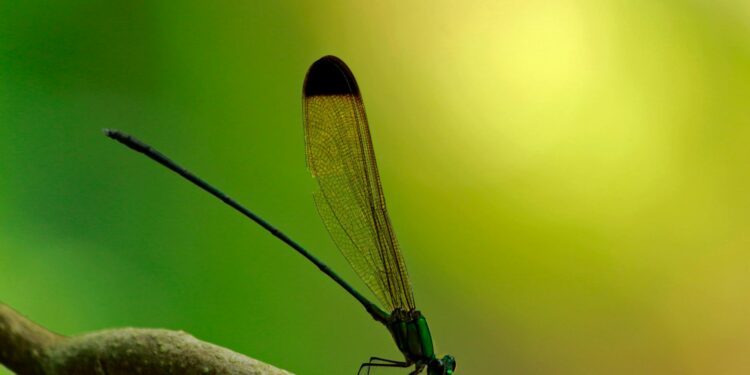Adeleke S. O.;1 , Sanni R. O.;2 , Adebayo V. J.;3 , Olaseewo N. A.;4 & Abdulwakeel K. D.5
1Adeyemi Federal University of Education, Ondo State, Nigeria
*Corresponding Author Email: adelekeso@aceondo.edu.ng …
Highlights
Abstract
Odonata, which includes dragonflies and damselflies, play crucial roles in both terrestrial and aquatic ecosystems, serving as key indicators for biomonitoring and as natural pest controllers. This chapter thoroughly examines the morphological differences between the larvae and adults of the Odonata suborders, Anisoptera (dragonflies) and Zygoptera (damselflies), alongside an investigation into their habitats, locomotion, dietary habits, and respiratory functions. It further explores the diversity across Odonata families and assesses their essential ecosystem services, particularly highlighting their role in sustaining environmental health and aiding in agricultural pest management. By comparing dragonflies and damselflies, this text accentuates their ecological value, especially in terms of environmental monitoring and their effectiveness in managing populations of disease vectors. This analysis aims to illuminate the pivotal role of Odonata in maintaining ecosystem vitality and their beneficial influences on human environments.
Keywords: Odonata, Biomonitoring, Ecosystem Services, Morphological Characterization, Pest Control.
1. Introduction
Insects inhabit nearly every environment except the deep sea, with many species residing in freshwater or salt marshes. Remarkably, insects like the ocean striders of the genus Halobates thrive on open ocean surfaces, yet the sea largely remains unconquered by adult insects. Due to their ubiquitous presence and impact on human life, insects are among the most studied invertebrates. Their significant role in pollinating most flowering plants (angiosperms), including crucial agricultural species, underscores their ecological importance. This mutual dependence between insects and flowering plants has fueled both their diversity and the intricacies of their relationships, making the study of these interactions a vibrant research area.
However, the rapid destruction of angiosperm habitats threatens numerous insect species with extinction in the coming years. Insects also draw scientific interest as vectors of diseases affecting humans and vertebrates, transmitting ailments such as malaria, bubonic plague, and Lyme disease through carriers like mosquitoes, sand flies, and ticks.
Besides being a menace to agriculture and spreading plant diseases, insects produce commercially valuable products like silk, honey, and beeswax, which find applications in various industries.
In biological control, insects like Odonata (dragonflies and damselflies) play a critical role as predators of pest species, both in larval and adult stages. Parasitoids, particularly from the Diptera (true flies) and Hymenoptera (wasps) orders, are pivotal in managing pest populations by developing inside and consuming their hosts.
The complex social behaviors, life cycles, and division of labor observed in some insect groups have captivated researchers, highlighting the vital functions insects serve in ecosystems. This chapter focuses on the Odonata, detailing their characteristics and ecosystem services, aiming to enrich the understanding of natural history enthusiasts, scientists, and conservationists. It seeks to provide comprehensive yet accessible information on Odonata and their role in ecosystems, hoping to contribute meaningfully to the fields of entomology, environmental management, and conservation biology.
2. Odonata
Odonata, encompassing dragonflies and damselflies, stand out as emblematic creatures of freshwater ecosystems, boasting over 6500 species worldwide (Clausnitzer and Dijkstra, 2005; Adu et al., 2019). Their considerable diversity, straightforward identification, and visibility have rendered them invaluable for biodiversity studies (Vick, 2003; Adu et al., 2015) and as prime bioindicators for assessing the ecological integrity of ecosystems (Corbet, 2004). Belonging to the order of flying insects, Odonata comprises dragonflies and damselflies, which are thought to have first appeared during the Triassic period (Kehli et al., 2016).
The Odonata order is split into two suborders, each showcasing distinct biological traits. Dragonflies, categorized under the suborder Anisoptera, are generally larger, with their eyes close together and wings held open or upright when at rest (Fig. 5). In contrast, damselflies belong to the suborder Zygoptera and are typically smaller, with their eyes set wider apart and wings held close to the body when at rest (Fig. 4). Both suborders feature aquatic larvae, known as naiads (nymphs), and are carnivorous throughout their life stages. Adult Odonata are adept fliers but seldom walk, as their legs are adapted for seizing prey, feeding primarily on insects.
3. Systematics and Taxonomy
Odonata, encompassing dragonflies and damselflies, is closely linked to mayflies and various extinct groups within Palaeoptera, though this association might be paraphyletic due to shared wing characteristics, including their articulation and positioning at rest.
In broader classifications, odonates are sometimes included within the super-order Odonatoptera, excluding the ancient Protodonata (Trueman and Rowe, 2008). In such contexts, the term Odonatoidea might be employed instead of Odonatoptera to denote this broader grouping (Lohmann, 1996).
Historically, Anisoptera, representing dragonflies, was treated as a sub-order, alongside a third sub-order called Anisozygoptera, which refers to ancient dragonfly species (Rehn, 2003). The current consensus, as reflected in the World Odonata List, acknowledges Anisoptera and Zygoptera (damselflies) as sub-orders, with Anisozygoptera also recognized, indicating a preference for these terms within the scientific community (Bechly, 2002; Dijkstra, et al., 2011).
4. Features of Larvae and Adults Dragonfly and Damselfly
Within the Odonata order, encompassing both dragonflies and damselflies, all members undergo a life cycle that includes aquatic larvae stages and terrestrial adult stages. This unique life cycle serves as the initial distinguishing feature separating them from other orders of aquatic insects. Furthermore, the differentiation between the suborders of dragonflies (Anisoptera) and damselflies (Zygoptera) involves specific characteristics:
4.1 Features of Larvae
Larvae of both dragonflies and damselflies exhibit varied body shapes, ranging from elongated and thin to long and stout, or even rounded and moderately flattened. The length of mature larvae across species spans from 13 to 68mm, excluding any present gills.
At the order level, larvae of dragonflies and damselflies can be distinguished from other aquatic insect larvae by distinct traits:
- The lower lip (labium) is long, elbowed, and folds back against the head when not in use, hiding other mouthparts.
- Wing pads are visible on the thorax.
- Three pairs of segmented walking appendages extend from the thorax.
- The segmented legs end in two claws.
- No gills are found on the abdomen sides, but some species possess three flat, elongated gills at the abdomen’s end.
At the suborder level, dragonfly larvae differ from damselfly larvae with these features:
4.1.1 Dragonfly Larvae (Fig 2)
- Their bodies can be long and stout or rounded and flattened.
- The head is narrower than the thorax and abdomen.
- Gills are absent at the abdomen’s end.
- Three short, stiff, and pointed structures form a pyramid-shaped valve at the abdomen’s end (rectum).
4.1.2 Damselfly Larvae (Fig 4)
- Elongated and thin bodies.
- Bodies broader than the thorax and abdomen.
- Three flat and elongated gills projecting from the rear of the abdomen, facilitating their distinction.
4.2 Features Distinguishing Adult Odonates from other adult aquatic insects.
Within the order Odonata, which includes dragonflies and damselflies, adults can be distinguished from other adult aquatic insects through a series of distinct characteristics (Fig 5, 6, & 7):
- The head is disproportionately large compared to the body.
- The compound eyes, which occupy a significant portion of the head, are large.
- Their wings are membranous, featuring numerous veins.
- At rest, their wings are either held extended above the body or spread out to the sides.
- All wings are elongated, with the hind wings being the same size as or larger than the front wings.
- The abdomen is notably long.
4.2.1 Adult Dragonfly (Fig 5) (Daigle, 1992)
- Their wings are spread out to the sides when at rest.
- Hind wings are broader at the base compared to the narrower forewings.
- The abdomen is long and stout.
4.2.2 Adult Damselfly (Fig 6, 7) (Daigle, 1991)
- Their wings are held together and extended along the body when they land.
- Forewings and hind wings are similarly shaped.
- The abdomen is elongated and very thin.
5. Habitat, Movement, Feeding and Breathing of the Odonates
Exploring the habitat, movement patterns, feeding mechanisms, and respiratory systems of Odonata in detail is crucial, as it enhances our understanding of these species and the ecosystem services they provide. This chapter aims to illuminate the distinctive nature of Odonata and their valuable contributions to ecosystems.
5.1 Odonates Habitats
Odonates, encompassing dragonflies and damselflies, inhabit a diverse array of environments, including seeps, brooks, creeks, streams, pools, ponds, lakes, reservoirs, swamps, and marshes (James and Rogers, 2011). Most odonate larvae are found in still waters, such as lentic-littoral (near the shore of lakes and ponds) or lotic-depositional (slow-moving waters where sediments accumulate) habitats. A smaller number reside in lotic-erosional habitats, characterized by faster-flowing waters that erode rather than deposit materials. While some odonate families are versatile, thriving in nearly all the aforementioned habitats, others display a more selective habitat preference, necessitating specific environmental conditions.
5.2 Movement of Odonates
Odonate larvae, including both dragonflies and damselflies, exhibit adaptations that enable them to thrive in aquatic habitats with varying substrate types, ranging from firm to soft. These larvae typically fall into one of four categories based on their movement habits: Climbers, Crawlers, Sprawlers, or Burrowers. While damselflies rarely exhibit sprawling or burrowing behaviors, such modes of existence are relatively common among dragonfly species.
5.3 Feeding Strategies of Odonates
All odonates are engulfing predators, capturing their prey with a distinctive lower lip (labium) that is not found in other insects, whether terrestrial or aquatic. This lower lip can swiftly extend in front of their head to grasp prey with its sharp, finger-like lobes before bringing it back to the mouth for consumption. Larger prey items are cut and torn into manageable pieces with other sharp mouthparts. This unique feeding mechanism allows odonate larvae to keep their legs free for movement and substrate attachment.
Odonate larvae are visual predators, employing different strategies for prey capture. Climbers and crawlers tend to actively stalk their prey, whereas sprawlers and burrowers typically lie in wait to ambush their targets. They feed on any prey they can overpower.
5.4 Breathing System of Odonates
The respiratory systems of odonate larvae differ between suborders. Dragonfly larvae possess internal gills located within a chamber at the abdomen’s end, where they actively pump water to ensure a continuous supply of oxygen-saturated water. Conversely, damselfly larvae have three external, leaf-like gills at the abdomen’s end for oxygen absorption. These gills are fragile and can be lost without fatal consequences, as damselfly larvae can also absorb oxygen through their skin and the thin lining inside their abdomen.
In low oxygen conditions, both dragonfly and damselfly larvae can resort to emergency breathing mechanisms. This includes climbing out of the water to allow atmospheric oxygen to diffuse into their body through a thin layer of water or directly exposing their internal or external gills to the air. This adaptability highlights the remarkable physiological features that enable odonates to occupy a variety of aquatic environments and contribute significantly to their ecosystems.
6. Common Family Of Odonata (Table 1, 2)
Odonata, a term which translates to “toothed-ones,” encompasses over 5,000 extant species that are distributed across the sub-orders Zygoptera (damselflies) and Anisoptera (dragonflies). The species count within each sub-order is approximately equal. These species are further classified into eight living superfamilies, which are subdivided into twenty-seven families and encompass slightly more than six hundred genera.
Table 1: Suborder Zygoptera (damselflies)
| – | Super Family | Family |
| – | Hemiphlebioidea | Hemiphleblidae |
| – | Coenagrionoidea | CoenagrionidaeIsostictidaePlatycnemididaePlatystictidaeProtoneuridae Pseudostigmatidae |
| – | Lestoidea | LestidaeLestoideidaeMegapodagrionidaePerilestidaePseudolestidaeSynlestidae |
| – | Calopterygoidea | AmphipterygidaeCalopterygidaeChlorocyphidaeDicteriadidaeEuphaeidaePolythoridae |
7. Ecosystem Services Of Odonata
Odonates, encompassing dragonflies and damselflies, play multiple roles in ecosystems, contributing to various services as discussed below:
7.1 As indicators of living organisms
Odonates, encompassing both dragonflies and damselflies, spend portions of their immature and adult life stages within aquatic ecosystems. They provide society with unique insights into the condition of these environments. The presence of odonate larvae in water bodies serves as an indicator of sufficient levels of dissolved oxygen, essential for the health of aquatic habitats. However, odonates are sensitive to pollution, particularly to environments contaminated with pesticide residues. This intolerance makes them excellent bioindicators, signaling the absence of harmful pollutants and the overall health of aquatic ecosystems.
Thus, the presence of swarming immature odonates in an aquatic ecosystem suggests a high level of dissolved oxygen, distinguishing these environments from polluted water bodies that contain residues of pesticides, herbicides, and similar contaminants.
7.2 In Military Science
Interestingly, the design of commercial aircraft has been influenced by the anatomical and flight patterns of odonates. Aeronautical engineers have studied the aerodynamics of dragonfly flight, applying these findings to the development of new wing designs for aircraft. This cross-disciplinary application showcases the remarkable impact of nature on technological innovation.
7.3 Odonates Serve as Carnivores
Odonate larvae play a crucial role in regulating mosquito populations within aquatic systems, effectively reducing insect pest numbers. Their carnivorous nature allows them to consume significant quantities of mosquito larvae in a short period. This natural pest control method diminishes the need for chemical sprays and other harmful pest management practices.
7.4 Advantageous to Human as Predator
The significant benefit of odonates, particularly adult dragonflies, to humans lies in their essential role in controlling populations of mosquitoes, midges, flies, and other bothersome insects (Muhammad and Umar, 2018). Given the global awareness that mosquitoes can transmit disease-causing organisms, including viruses, Dengue, and Malaria, odonates provide a natural advantage by consuming these nuisance insects, thereby contributing to the reduction of disease transmission risks.
7.5 Odonates as Sources of Food
Odonates serve as vital food sources for a wide range of species, including mammals, birds, reptiles, amphibians, fishes, and even humans. Across various parts of the world, insects are a significant component of the diet. Odonates, both nymphs and adults, are notably nutritious, comprising approximately 46 – 65% crude protein, making them an important nutritional resource in many ecosystems and human cultures alike.
Table 3: Comparison between dragonfly and damselfly
| S/N | Dragonfly | Damselfly |
| 1. | Dragonflies have large eyes | The eyes are large but there is a presence of gap in between eyes |
| 2. | The hind wings are slightly broader compared to the forewings | Both hind and forewings are more or less similar size |
| 3. | The wings are positioned horizontally to the body in dragonflies while at rest. | The wings are placed perpendicularly to the body in damselflies when land on the substrate. |


8. Conclusion
The chapter delineates odonates, encompassing dragonflies and damselflies, as integral components of the flying insect order. Characterized by their life cycle stages—commencing as aquatic larvae before transitioning to terrestrial adults—odonates are highlighted for their pivotal role within ecosystems. Conclusively, the chapter underscores that odonates provide significant economic advantages, enhance human well-being through aesthetic and spiritual contributions, and act as efficient predators of disease vectors and agricultural pests, thereby underscoring their indispensable value
Conflict of Interest
There is no conflict of interest during the completion of the research.
References
Adu, B. W., Akindele, E. O., & Obadofin, A. A. (2015). Comparison and distribution of dragonflies and damselflies (Insecta: Odonata) in Iloyin forest, Akure, Southwestern, Nigeria. Ethiopian Journal of Environmental Studies and Management, 8(5), 517-529.
Adu, W. B., Amusan, B. O., & Oke, T. O. (2019). Assessment of the water quality and Odonata assemblages in three waterbodies in Ilara-Mokin, South-western Nigeria. International Journal of Odonatology. DOI: 10.1080/13887890.2019.1593889
Bechly, G. (2002). Phylogenetic systematic of odonata. In M. Schorr & M. Lindeboom (Eds.), Dragonfly Research. Classification and diversity of dragonflies and damselflies (Odonata) (pp. 36-45). Zerf-Trubingen: Zootaxa.
Clausnitzer, V., & Dijkstra, K.-D. B. (2005). The dragonflies (Odonata) of Ethiopia, with notes on the status of endemic taxa and description of new species. Entomolische Zeitschrift, 115, 117-130.
Corbet, P. S. (2004). Dragonflies: Behaviour and Ecology of Odonata. Colchester: Harley Books.
Daigle, J. J. (1991). Florida damselflies (Zygoptera): A species key to the aquatic larval stages. State of Florida Department of Environmental Regulation. Technical Series, 11(1).
Daigle, J. J. (1992). Florida dragonflies (Anisoptera): A species key to the aquatic larval stages. State of Florida Department of Environmental Regulation. Technical Series, 12(1).
Dijkstra, K.-D. B., Bechly, G., Bybee, S. M., Dow, R. A., Dumont, H. J., Fleck, G., … Ware, J. (2011). Field guide to freshwater Invertebrates of North America.
James, H.T. and Rogers, D.C. (2011): Field guide to freshwater Invertebrates of North America.
Lohmann, H. (1996). Das phylogenetische system der Anisoptera (Odonata). Deutsche Entomologische Zeitschrift, 106, 209-266.
Muhammad, Y. A., & Umar, N. (2018). Role of Odonates as beneficial insects in nature. Palaeontologia Electronica, 19(1). DOI: 10.268791576.
Rehn. (2003). Dragonflies are dangerous beauties. The National Wildlife Federation.
Vick, G. S. (2003). Biodiversity assessment of the Odonate fauna of the Takamanda Forest Reserve, Cameroon. SI/MAB Series, 8(1), 73-82.
About this Article
Cite this Article
APA
Adeleke S. O., Sanni R. O., Adebayo V. J., Olaseewo N. A. & Abdulwakeel K. D. (2024). ODONATA: Characterisations and their Ecosystem Services. In K. S. Adegbie, A. A. Akinsemolu, & B. N. Akintewe (Eds.), Exploring STEM frontiers: A festschrift in honour of Dr. F. O. Balogun. SustainE.
Chicago
Adeleke S. O., Sanni R. O., Adebayo V. J., Olaseewo N. A. & Abdulwakeel K. D. 2024. “ODONATA: Characterisations and their Ecosystem Services.” In Exploring STEM Frontiers: A Festschrift in Honour of Dr. F.O. Balogun, edited by Adegbie K.S., Akinsemolu A.A., and Akintewe B.N., SustainE.
Received
22 November 2023
Accepted
12 February 2024
Published
26 February 2024
Corresponding Author Email: olademojo@aceondo.edu.ng
Disclaimer: The opinions and statements expressed in this article are the authors’ sole responsibility and do not necessarily reflect the viewpoints of their affiliated organizations, the publisher, the hosted journal, the editors, or the reviewers. Furthermore, any product evaluated in this article or claims made by its manufacturer are not guaranteed or endorsed by the publisher.
Distributed under Creative Commons CC-BY 4.0
Share this article
Use the buttons below to share the article on desired platforms.














